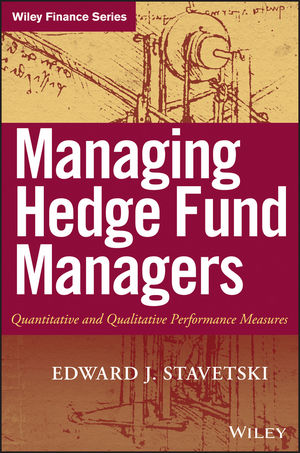Managing Hedge Fund Managers: Quantitative and Qualitative Performance MeasuresISBN: 978-0-470-19759-2
Hardcover
272 pages
March 2009
 This is a Print-on-Demand title. It will be printed specifically to fill your order. Please allow an additional 10-15 days delivery time. The book is not returnable.
|
||||||
Highlights of the Book.
Acknowledgments.
Introduction.
The Art and Science of Hedge Fund Investing—Are You Precisely Wrong or Approximately Correct?
The Explosion of Hedge Funds.
What are Hedge Funds?
Finding a Comfort Zone.
A Look beneath the (Book) Covers.
As You Begin.
Chapter 1. Asset Allocation and Fiduciary Duty.
Investment Policy Statement: The Roadmap.
Determinants of Portfolio Performance.
Why Alternate Investments?
A Closer Look at Hedge Fund Structures.
The Rise of Socially Responsible Investing.
Fiduciary Responsibility.
Where Do I Start?
Chapter 2. Large Versus Small Funds.
Good Things in Small Packages.
Research Confirms Small Fund Advantage.
Performance of New Small Funds.
Attrition Rates.
Drivers of Outperformance.
Invested Interests.
Aligned Interests.
Point of Diminishing Returns.
Master of Trend line Analysis.
Chapter 3. The Search for an Honest Man.
Finding Your Manager.
Prime Brokers.
Conferences and Industry Events.
Industry Publications.
Incubators and Platforms.
Industry Websites and Databases.
Building Your Own Database.
Unconventional Sources.
Six Steps to Kevin Bacon.
Sizing up the Flock.
What's in the DDQ?
Summary.
Chapter 4. Performance Analysis.
Torturing the Numbers Until They Confess.
The First Step: Understand What Is Being Measured.
Two Sides to Hedge Fund Performance: Long and Short.
Performance Standards.
Check the Entry
Finding a Benchmark
Peer Analysis
Confusion from the Best and the Brightest?
A Practitioners View.
Examine the Bad.
Examine the Good.
Expect the Improbable.
I Surrender.
Chapter 5. Risk in Hedge Funds.
Risk Is Like the Weather: Everyone Talks About It, but No One Does Anything About It.
Major Risk Categories.
Liquidity Risk.
High Watermark Risk.
Concentration Risk.
Operational Risk.
Liquidity Mismatch Risk.
Transparency Risk.
Risk Process.
Leverage Risk.
Short Selling Risk.
Reputation Risk.
Submerged Risk.
Counterparty Risk.
Market Risk.
Credit Risk.
Model Risk.
Complexity Risk.
Key Person Risk.
Sensitivity to Assumptions Risk.
NAV Instability Risk.
Derivatives Risk.
Summary.
Chapter 6. You Only Find out Who Is Swimming Naked When the Tide Goes Out.
Look Behind the Numbers.
Filling out the DDQ.
Form ADV Part II.
Fund Brochures and Documents.
Planning the On-Site Visit.
Summary.
Chapter 7. Let the Games Begin.
The Due Diligence Process.
The Process.
Examining the Organization.
Preparing for the On-Site Visit.
Preparing the Final Evaluation.
In Conclusion.
Chapter 8. Getting Ready is the Secret to Success.
Portfolio Construction.
Top-Down Strategy Analysis.
Bottom-up Manager Analysis.
Test or Model the Portfolio.
Portfolio Optimization.
Summary.
Chapter 9. Navigating Buyers Remorse.
It's Always Darkest Before It Goes Completely Black.
Long Term Capital Management: Poor Diversification and High Leverage Are a Dangerous Combination.
Bayou Group, LLC: Due Diligence is a Must.
Wood River Capital Management: A Lack of Experience and Auditing.
MotherRock: The Liquidity Squeeze in a Small Market Will End Badly When Volatility Increases.
Amaranth: Liquidity and Concentrated Portfolios Can Drag a Fund down as Trend of Any Trade Eventually Reverses.
Recent Events: Ospraie Fund.
Your Final Exam.
Applying Your Education.
The Importance of Second Acts.
Chapter 10. Monitoring Your Flock.
I Walk in the Valley Darkness, I Fear No Evil.
Everyone's Favorite Metric: Performance.
Portfolio Exposures.
Performance Trends.
Peer Group Analysis.
Strategy Reviews.
Fund Size and Performance Impact.
Management and Personnel Reviews.
Third Party Vendors.
Regulatory and Legal Risk.
Business Continuity Risk.
A Final Word on Monitoring.
Appendix A. Sample Investment Policy Statement.
Investment Policy Statement for Wilmington Family Office.
I. Statement of Investment Objectives.
II. Asset Allocation & Rebalancing.
III. Guidelines for the Selection of Fixed-Income Securities.
IV. Guidelines for Selection of Equity Investments.
V. Standards of Performance.
VI. Selection of Managers.
VII. Responsibilities of Managers.
Appendix B. Sample ADV Part II with ADV Schedule F.
Appendix C. Hedge Fund Manager Due Diligence Questionnaire.
I. Background.
II. Investment Process, Strategy, and Philosophy.
III. Business Plans.
IV. Manager Selection and Research.
V. Manager Monitoring and Risk Management.
VI. Performance and Fees.
VII. Compliance and Client Reporting.
VIII. Personnel.
IX. Operations and Administration.
X. Taxes.
XI. Performance (See Attached – Appendix 6).
Attachments.
Appendix D. U.S. Equity Long/Short Managers.
Proposal Questionnaire.
A. Organization.
B. Investment Professionals (Product Specific).
C. Investment Philosophy and Process.
D. Trading Process and Systems.
E. Performance.
F. Composite/Product Information.
G. References.
Bibliography.
Chapter 1.
Chapter 2.
Chapter 3.
Chapter 4.
Chapter 5.
Chapter 6.
Chapter 7.
Chapter 8.
Chapter 9.
Chapter 10.
Index.



